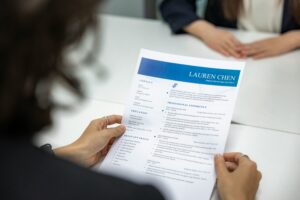

Picture this: you are welcomed into a beautiful foyer or a sitting room and you are immediately captivated by the cleanliness, attention to detail and other functional elements in the room. Often, waiting rooms like these reflect the cleanliness and orderliness of the rest of the building. They are a glimpse into what to expect, and they definitely make a striking impression. In many ways, a cover letter should give employers the same experience.
A well-written, organised and detailed cover letter gives prospective employers a good idea of what to expect. Cover letters, quite literally, serve as a preview for a resume or application document, and in line with best practice one should always include one as a courtesy or even just as an expression of interest in the role.
Types of cover letters
Cover letters are best written or modified to target specific points in a job description or a position vacancy. While a speculative cover letter is a good place to start, one must always tailor them to respond to the specific requirements in a notice. This shows your attention to detail and your strong interest in proving to the employer that you are a perfect fit for the role.
A cover letter usually accompanies a resume and is regarded as an vital part of an application package submitted to a prospective employer. Additional to sending a well laid-out resume, sending a cover letter signals extra attention and finesse. It should follow the structure and format of a business letter, and must contain key parts: an introduction, a body, and a conclusion.
Following this structure ensures you are able to grab the hiring manager’s attention, that you are able to provide a good first impression with a summary of your accomplishments, and more importantly, that you are able to express a strong desire in being selected for the role. By including a conclusion, often a call to action, such as asking the hiring manager to contact you for inquiries or by proactively asking to be invited for an interview, you are able to end your letter with a strong statement, sending a convincing message that you are deserving of an invite.
One-page cover letters differ from selection criteria or custom response cover letters in that they summarise and package information in a more compact narrative. Cover letters document one’s work history, professional skills and objectives in applying for a job.
Cover letters also direct the resume and the application package to a specific contact or office in the department, making sure that your resume gets to the right place for the selection process.
That being said, some organisations and companies may require applicants to outline specific experiences that respond to the key selection criteria of the role. This is where Selection criteria documentscome in to play. They may also take the form of cover letters, but they are a much more complex and structured format.
STAR responses;
One best-practice strategy one must comply with is outlining skills and capabilities through STAR responses. Also known as SAO, these invaluable narratives relate to the key selection criteria detailed in the job notice or posting. Selection criteria responses in the STAR format are so-called because it follows a highly organised pattern of presenting the Situation, Task, Action, or Result/Outcome for each skill.
Selection criteria cover letters with the STAR format are highly detailed and are focused on highlighting the applicant’s instrumental role in leading the task or the project to its completion. Often, it includes specific figures, steps, and illustrations of how the applicant is able to demonstrate a skill. Apart from setting the context of the narrative, one must include the specific task or project undertaken so as to emphasise one’s role in the project. It must be presented in such a way that without the applicant’s integral part, the project would not have been successful. This strategic way of highlighting contributions show that you are an indispensable part of the team.
Furthermore, by presenting a clear picture of key action steps and specific processes undertaken, an applicant is able to contextualise how transferrable skills can be used in a variety of challenging situations. Finally, by presenting the resolution or outcome of the task at hand, an applicant completes the STAR outline and rounds up the discussion on how they were able to utilise their skills and resources to get the job done. All of these are in the hope of convincing the employer that an applicant is able to utilise their skills to abide by the company’s objectives and desired outcomes and it a perfect fit for the new position.
Other things to consider
It is important to note that a cover letter must complement the resume. Contrary to belief, it is good practice to echo (not completely repeat) the contents of one’s resume in cover letters. Similar to the analogy of the sitting room, or a dazzling appetiser to start off a meal, cover letters must intrigue and spark curiosity, encouraging the employer to go to the next page and go through your body of work and experiences. Once you are able to stop an employer in their tracks, only then you have truly mastered the art of capturing attention and drawing curiosity to your competencies, skills, experiences, and objective statements.
Our Team are glad to assist you in completing a compelling, flawless and striking resume and cover letter package that will wow a prospective employer. Our years of experience and expertise is backed by our insights into hiring practices and requirements. We have worked with thousands of application packages and have advised successful applicants in securing that coveted, highly competitive position.
Contact us today to begin building your outstanding cover letter and application documents!



Suite 7, Level 1, 52 Davidson Terrace, Joondalup WA 6027, Australia
Call us: 1300 174 435
Email us: [email protected]